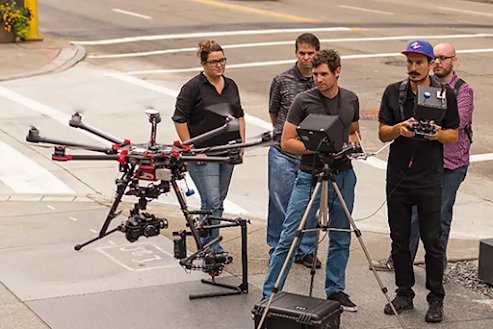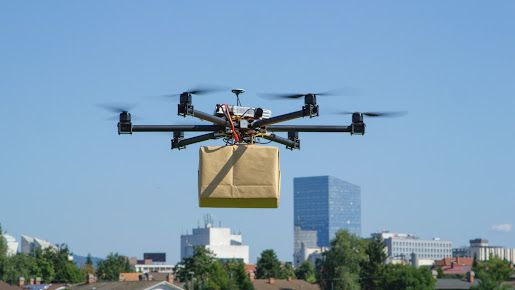Drone's Versatility & Applications
Introduction
Drones are cutting-edge technology that can be modified to fulfil certain needs. By offering quick, easy, and inexpensive answers to issues, they have changed several sectors.
We 'll explore the top 9 uses for drones in this blog.
1. Agriculture
- Drones are frequently used in agriculture to map the land, analyze the soil, monitor crop health, and control irrigation systems.
- The drones can take high-resolution pictures of plants using sensors and sophisticated cameras, giving farmers comprehensive information on plant development and health.
- This makes it possible for farmers to see issues like sickness or hunger early on and take the required steps to stop its spread.
- Drones can also assist increase irrigation efficiency by accurately reporting crop and soil water requirements.
- Farmers may raise yields, save expenses, and improve the sustainability of their operations by employing unmanned technology.

2. Search and Rescue

- In search and rescue operations, drones can cover large mountainous areas in a relatively short period of time compared to conventional search methods such as foot patrol people or helicopters.
- This technology can help rescuers in dangerous situations by providing real-time video images and identifying potential obstacles or hazards in the area.
- In addition, drones can keep rescue teams aware of situations and improve overall communications by sending data and images to the command center.
- Using drones in search and rescue can reduce response time and save lives.
3. Construction
- Drones have become an increasingly popular tool in the construction industry because of their cost-effectiveness and efficiency.
- It provides a quick and easy way to explore and map construction sites, monitor progress and inspect buildings.
- Engineers and architects will be able to use special cameras and sensors to create more accurate 3D architectural models, enabling improved collaboration and communication between project teams and stakeholders.
- Drones can also be used to detect potential hazards to ensure worker protection and construction site safety.
- In addition, drones record the construction site during construction, providing valuable records for future use and analysis.
- The use of drones in construction can help project managers save time and money while increasing productivity and safety on the job site.
4. Mining
- The drone, which has highly specialized sensors and cameras, can create detailed 3D maps of mines, giving accurate information about their positions and environmental conditions.
- By using this data, drilling operations may be planned and designed more effectively, and possible safety risks can be found.
- Drones may also be used to monitor and evaluate how environmental variables like water pollution and soil erosion affect the ecosystem.
- This aids mining businesses in adhering to environmental laws and lessens their negative effects on the ecology in the area.
- Companies in the mining industry will boost output, save costs, and improve security and safety by adopting drones technology completely.
5. Wildlife Conservation
- Drone technology can help scientists and environmentalists do their jobs better5.
- By allowing scientists to follow animals, view their habitats, and gather data for scientific studies, drones have emerged as an important tool for wildlife conservation.
- The drone can record high-resolution photographs and videos of animals using specialized cameras and sensors, enabling researchers to study animal wildlife and movement.
- The most difficult to reach places where conventional animal management techniques are impractical are where this technology is most helpful. Drones may be used to map and monitor animal habitats, revealing important information on how human activities and environmental change affect wildlife populations.
- Drones can also assist anti-poaching operations by spotting and following unlawful activity in protected regions.
- Researchers and environmentalists can better understand the habitats and behaviour of wildlife by using drones.
6. Real Estate
- A viewfinder can take high-quality photographs and movies from various angles thanks to specialized cameras and sensors, giving potential buyers a wealth of information about the property.
- With the use of this technology, real estate brokers may produce excellent marketing materials that can be utilized to emphasize a property's distinctive qualities, such as location, size, and amenities.
- Drones may also aid property managers in locating places that require upkeep, such as a leaking roof or spots that require cleaning or repair.
- Real estate companies may simplify their marketing initiatives, draw in new customers, and ultimately sell homes faster by deploying drones.
7. Disaster Relief
- In addition to assessing the damage and coordinating rescue operations, drones can also deliver essential supplies such as medical supplies, food and water to the affected areas.
- This is especially useful in situations where roads are inaccessible or too dangerous to navigate.
- Drones can travel quickly and effectively over long distances to help those in need. Besides, drones equipped with thermal cameras can be used to identify survivors even in light or dark conditions.
- Rescuers can save valuable time and resources because they can be directed to the exact location they need.
- Overall, drones have the potential to transform disaster management by providing a faster, more efficient and safer way to respond to emergencies.
- As technology continues to improve and become more accessible, we can expect to see drones play an increasingly important role in disaster response and recovery efforts worldwide.
8. Filmmaking
- By enabling the low-cost capturing of breathtaking aerial video that was previously only feasible with pricey equipment, drones have transformed filmmaking.
- This gives the video a more cinematic appearance by enabling the filmmakers to fly and swivel the camera to capture various views and perspectives.
- Filmmaking drones are substantially quieter than standard drones, making them ideal for shooting in populated areas or protected natural regions.
- Drones can also take aerial pictures of places and things that are impossible for regular cameras to.
- We may anticipate seeing an increasing number of inventive and unique films as drone technology advances.
9. Package Delivery
- By offering a quick and easy means to transport items, drones have the potential to transform the logistics sector.
- Remote deliveries are made possible by this technology, further cutting delivery times and increasing productivity.
Conclusion
Drones have shown to be useful assets in many sectors, and they have a wide range of uses. Over time, we may anticipate seeing more advanced and creative drones employed as technology advances.
It's crucial to learn how to fly and use drones in these kinds of applications on the snow in order to keep one step ahead of the curve as demand for unmanned technology increases.
You may expand your company options and help sectors like agriculture, emergency services, and utilities develop by becoming an expert in drone technology. Start studying about drones right away to ensure you don't lose your chance to be at the forefront of this innovative and quickly developing technology.











0 Comments